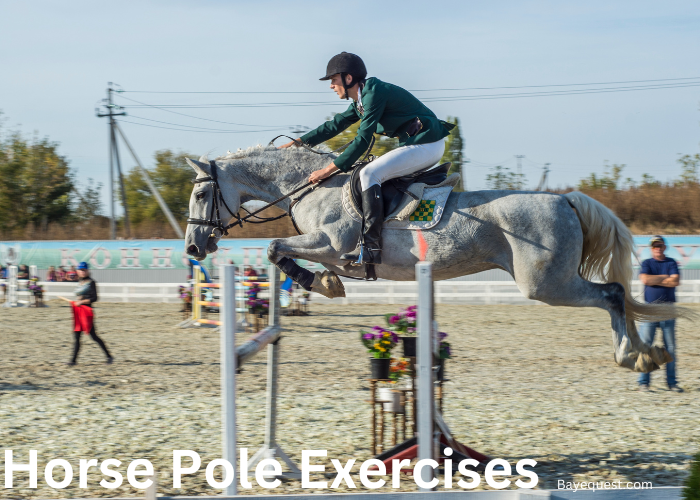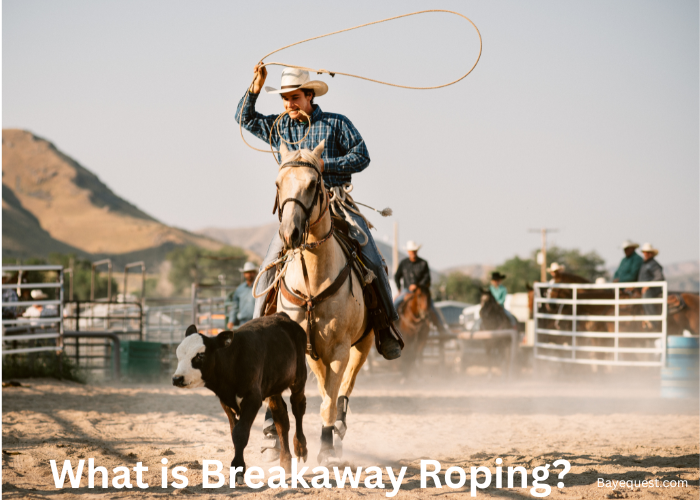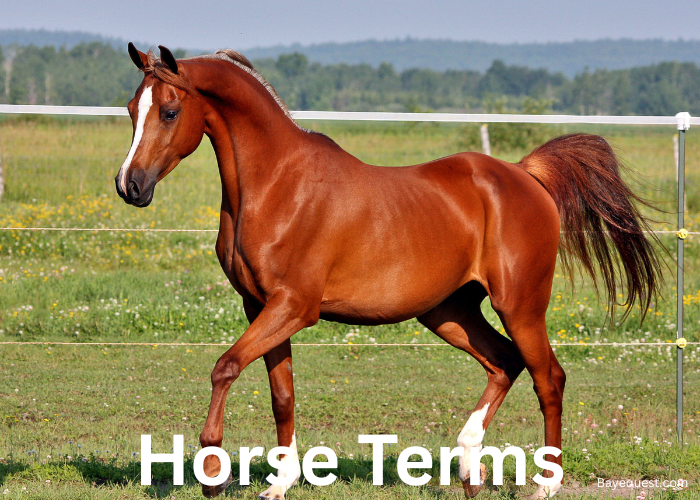Poles aren’t just for jumping. They’re a game-changer for any horse, no matter the discipline.
From improving balance to building muscle, pole exercises turn basic rides into brain-boosting workouts.
They teach your horse to think, step carefully, and stay engaged. Best of all? You don’t need fancy equipment, just a few poles and a plan.
Whether you want smoother transitions, better flexibility, or a stronger topline, pole work can help.
Ready to level up your training? Let’s break down the best pole exercises for balance, strength, and precision.
Your horse will thank you.
What are Horse Pole Exercises?
Horse pole exercises use ground poles, raised poles, or cavaletti. They help a horse move better and stay focused.
The exercises involve walking, trotting, or cantering over poles. Different setups improve flexibility, engagement, and jumping skills.
They can be used for young horses, dressage training, or jump preparation. Pole work is simple but effective, making training more interesting.
Importance of Horse Pole Exercises
Horse pole exercises are more than just stepping over poles. They help refine movement, build strength, and sharpen focus.
Here’s why they matter:
Improves balance and coordination. Teaches the horse to control its feet and move with better stability.
Encourages proper muscle development. Strengthens the topline, hindquarters, and core muscles.
Enhances stride control and rhythm. Helps regulate pace and develop consistency in movement.
Boosts engagement and focus. Keeps the horse mentally sharp and responsive to cues.
Increases flexibility and suppleness. Encourages smooth bending and lateral movement.
Prepares for jumping and obstacles. Builds confidence and accuracy for navigating courses.
Adds variety to training. Prevents boredom and keeps workouts interesting for both horse and
rider.
Read also: Best Equestrian Workout to Improve Your Riding.
Ground Pole Measurements for Horses
The spacing of ground poles depends on the horse’s stride and gait.
For walking, poles should be 2.5 to 3 feet apart. For trotting, space them 4 to 4.5 feet apart. Canter poles need more room, usually 9 to 12 feet apart.
Bigger horses may need wider spacing, while ponies might need shorter distances. Start with these basic measurements, then adjust based on how your horse moves.
If the horse trips or struggles, the poles may be too close. If it takes extra steps, they might be too far apart.
Always watch how your horse moves through the poles. A relaxed and steady rhythm means the spacing is right.
Ground poles help improve balance, coordination, and stride control.
Using the correct distances ensures the horse moves comfortably and gains the most from the exercise.
Beginner Pole Work Exercises for Horses
Pole exercises don’t have to be complicated. Simple setups can improve balance, rhythm, and coordination.
These beginner exercises are great for all horses, whether young, green, or needing a refresher.
Each setup helps with different skills, from straightness to bending and stride control. Let’s break down four easy pole exercises to get started.
The line
Lay 3 to 5 poles in a straight line with even spacing.
Use 4 to 4.5 feet between poles for trotting. For walking, space them 2.5 to 3 feet apart.
Start by walking your horse over the poles in a straight path. Keep a steady rhythm and even pace.
Once comfortable, move to a trot. Focus on keeping the horse straight and balanced.
Avoid rushing or letting the horse speed up. This exercise improves stride control, balance, and focus.
The fan
Arrange 3 to 4 poles in a fan shape, like spokes on a wheel. The narrow end should have 3 feet between poles.
The wider end should be 5 to 6 feet apart. Ride through the center for an even stride.
For more difficulty, move toward the narrow end. This exercise improves bend, flexibility, and coordination.
Keep the horse moving in a steady rhythm. Avoid letting the horse drift or rush.
The circle
Lay 4 to 6 poles in a circle, evenly spaced. Use 4 feet apart for a trot.
Place them wider for a canter. Ride the circle at a steady pace, keeping the horse balanced.
Stay on the correct bend and guide the horse through. Keep your hands soft and your legs steady.
This helps with flexibility, balance, and rhythm. Start with a walk or trot before trying a canter.
The square
Place 4 poles in a square shape, with open corners. Use 4 to 5 feet between poles.
Walk or trot through in straight lines. You can also turn and circle around the poles.
Keep the horse moving in a steady rhythm. Stay balanced and guide the horse smoothly.
This exercise helps with steering, balance, and precision. Try different patterns to make it more challenging.
Intermediate Pole Work Exercises for Horses
Once your horse has mastered basic pole exercises, it’s time to add more challenge.
Intermediate pole work builds strength, flexibility, and coordination. These exercises improve stride control, balance, and engagement.
Let’s explore some great pole setups to take your training to the next level.
Raised poles
For this, set 3 to 5 poles in a straight line or a circle. Raise them 6 to 12 inches off the ground using small blocks or jump cups.
Space them 4 to 4.5 feet apart for trotting. Start at a walk, allowing the horse to lift its legs higher. Move to a trot when ready.
Raised poles improve strength, engagement, and topline development. Keep the horse steady and balanced over the poles. Avoid rushing or tripping.
The double fan
Set up two fan-shaped pole patterns, one on each side of the arena. Space the poles 3 feet apart at the narrow end and 6 feet apart at the wider end.
Ride through the center first, then challenge the horse by moving toward the narrow side. Use smooth turns to connect both fans.
This exercise improves stride control, flexibility, and responsiveness. Keep a steady rhythm and guide the horse with soft hands and clear leg aids.
The spiral
Place 5 to 6 poles in a large circle, evenly spaced. Use 4 feet apart for a trot and 9 feet for a canter.
Start by riding the outer circle, then gradually spiral inward. Once in the center, move outward again.
This helps the horse learn to bend, balance, and control stride length. Keep the rhythm steady and avoid rushing.
This exercise improves suppleness, balance, and collection.
The clover
Set four poles in a plus (+) shape, forming a cloverleaf pattern. Space them 4 to 5 feet apart.
Approach the center, then turn in different directions to complete cloverleaf loops. Change direction often to keep the horse engaged.
This improves steering, precision, and responsiveness. Keep your aids clear and the horse balanced.
This exercise is great for improving quick turns and body control.
The zigzag
For the zigzag pattern, lay 5 to 6 poles in a zigzag way. Space 4 to 5 feet apart.
Ride through in a weaving motion, guiding the horse smoothly between poles. Keep a steady trot or canter while maintaining balance.
This exercise sharpens agility, coordination, and focus. Start with wide turns, then make them tighter as the horse improves.
Stay relaxed and use soft cues.
The triangle
Place 3 poles in a triangle shape, spaced 4 to 5 feet apart. Ride through in different patterns, straight across, weaving, or in circles.
Vary your approach to keep the horse thinking. This exercise develops precision, engagement, and stride control.
Keep your horse balanced and focused. Try changing gaits for an extra challenge.
Pole Exercises to Improve Balance and Coordination
Good balance and coordination help a horse move smoothly and confidently. Pole exercises encourage better body control, even strides, and focus.
Here are three effective exercises to boost balance and coordination.
Spaced walk and trot poles
Arrange four to six poles in a straight line with 2.5 to 3 feet between them for walking. For trotting, use a 4 to 4.5-foot gap.
Guide the horse through at a steady pace, keeping an even rhythm. Avoid rushing or hesitating.
This exercise helps the horse step carefully, maintain balance, and develop better stride control.
Offset poles
Position four to six poles in a staggered pattern, requiring the horse to adjust its steps. A 4 to 5-foot distance works well for trotting.
Move through at a relaxed pace, allowing the horse to think about each step. This setup challenges coordination and encourages better body awareness.
Walking first before trotting ensures the horse stays engaged and confident.
Cavaletti work
Raise four to six poles a few inches off the ground using small blocks or jump cups. A 4 to 4.5-foot spacing suits trotting.
Guide the horse over at a steady trot, focusing on balance. This exercise strengthens core muscles, improves coordination, and encourages an active hind end.
Keeping a relaxed, rhythmic pace leads to the best results.
Pole Exercises to Develop Strength and Engagement
The following exercises help build stamina, muscle, and self-carriage. Start slow, focus on rhythm, and let the horse find its natural flow.
Raised cavaletti
Lifting poles a few inches off the ground makes a big difference. Horses must lift their legs higher, activating core and hind muscles.
Use four to six poles with 4 to 4.5 feet in between for trotting. Keep the stride steady and allow the horse to push from behind.
This setup builds strength, improves topline development, and encourages better self-carriage.
Start low, then gradually raise the poles for more challenge.
Slow canter pole work
Cantering over poles at a controlled pace forces the horse to engage its hindquarters.
Arrange three to four poles 9 to 12 feet apart. Ride through with a steady, collected canter.
Avoid rushing or pulling back, and let the poles do the work. This exercise develops power, balance, and responsiveness.
It also helps refine stride control for better rhythm in more advanced work.
Hill pole work
Adding an incline makes pole work even more effective. Find a gentle slope and place four to six poles with normal trot spacing.
Moving uphill strengthens the hindquarters, while coming downhill improves control and balance.
Keep a steady pace and let the horse figure out its stride. This exercise builds endurance, engagement, and overall body strength.
Pole Exercises for Improving Flexibility and Suppleness
Pole work can help loosen stiff muscles, improve body control, and encourage softness in movement.
These exercises focus on bending, stretching, and lateral work to develop suppleness. Let’s have a look at some of them:
Bending poles on a circle
Arrange four to six poles evenly around a large circle. Keep them 4 to 5 feet apart for a trot.
Ride around the circle, encouraging the horse to bend through its body. Stay on the correct bend and avoid cutting corners.
This exercise improves lateral flexibility and helps the horse stretch through turns. It also teaches the rider to maintain steady contact and balanced aids.
Serpentine pole exercises
Position poles in a straight line, leaving 8 to 10 feet between them. Guide the horse through in a serpentine pattern, weaving left and right.
Keep the rhythm steady and encourage smooth turns. This exercise increases flexibility, encourages even bending, and strengthens lateral control.
It also helps the horse become more responsive to rein and leg cues.
Side-passing over poles
Place a single pole on the ground and approach it at a walk. Ask the horse to step sideways over it, crossing one leg over the other.
Keep movements slow and controlled. This exercise improves flexibility, lateral movement, and overall body coordination.
It also strengthens the horse’s core and encourages engagement from behind. Start with short steps, then increase the difficulty as the horse gains confidence.
Pole Exercises for Stride Control and Rhythm
The following exercises will help your horse with good stride control moves:
Evenly spaced canter poles
Arrange three to five poles in a straight line, 9 to 12 feet apart. Ride through at a relaxed canter, allowing the horse to step evenly over each pole.
Keep light contact and avoid micromanaging. The poles naturally encourage a steady stride.
If the horse rushes or shortens, adjust your approach to keep an even rhythm. This exercise improves consistency, balance, and self-carriage.
Varying pole distances
Set up three or more poles with different spacing, one slightly closer together, one farther apart.
Canter through, allowing the horse to adjust its stride as needed. This teaches stride lengthening and shortening without force.
Start with subtle variations, then increase the challenge as the horse improves. The goal is smooth, controlled adjustments rather than rushing or hesitation.
This exercise improves adaptability and responsiveness.
Jumping gridwork with poles
Use a series of poles before and after small jumps to help control takeoff and landing.
Start with trot poles leading to a small cross-rail, followed by a stride or two of canter poles. The setup keeps the horse balanced and prevents rushing.
Focus on staying straight and maintaining rhythm over each section. This exercise improves jumping technique, confidence, and overall rhythm.
Pole Exercises for Confidence and Focus
These setups improve problem solving skills, calmness, and trust in the rider. Let’s explore them widely:
Random pole placement
Scatter poles randomly across the arena, with no set pattern. Approach at a walk or trot, letting the horse figure out its path.
Encourage smooth steps and steady movement. This exercise teaches the horse to focus on foot placement, stay aware of its surroundings, and move confidently over uneven setups.
It also helps with agility and quick decision-making.
Multiple pole patterns
Use a mix of straight lines, curves, and grids to create a dynamic challenge. Ride different routes each time to keep the horse engaged.
Vary the speed and approach angles to prevent predictability. This exercise builds focus, adaptability, and responsiveness.
The horse learns to stay alert and follow cues without anticipating the next move.
Obstacle pole courses
Combine poles with small obstacles like cones, barrels, or cavaletti. Guide the horse through a winding path, encouraging steady movement.
Keep the pace relaxed and give the horse time to think. This setup mimics real-world trail obstacles, helping horses become braver and more adaptable.
It also improves coordination, patience, and rider horse communication.
Tips for Success with Horse Pole Exercises
Pole work is fun and effective, but only when done correctly. The right approach helps the horse gain balance, strength, and confidence.
Here are some key tips to get the best results:
Start simple. Begin with basic setups before moving to advanced patterns. Let the horse build confidence gradually.
Adjust pole spacing. Every horse has a unique stride. If the horse struggles, tweak the distances to fit its natural movement.
Keep a steady rhythm. Focus on even, controlled strides. Avoid rushing or pulling back too much. Let the poles encourage natural movement.
Use poles wisely. Don’t overwork the horse. Short, focused sessions are more effective than long, tiring ones.
Watch for fatigue. If the horse starts tripping or rushing, take a break. Tired muscles make mistakes.
Maintain straightness. Keep the horse straight through pole exercises, unless working on bending patterns. This prevents bad habits.
Mix it up. Change pole layouts regularly to keep the horse engaged and prevent boredom.
Stay safe. Always secure raised poles properly and check for hazards before starting.
Pole Exercises for Horses: Conclusion
Horse pole exercises are a simple way to improve balance, strength, and coordination. They keep training fun and challenge both horse and rider.
From basic walk poles to advanced grids, every setup has a purpose. Start with easy exercises, then increase difficulty as your horse improves.
Focus on rhythm, stride control, and smooth movement. Adjust pole spacing to match your horse’s stride.
Keep sessions short and positive to prevent fatigue. With patience and practice, pole work builds confidence and skill.
Try different exercises and see the difference in your horse’s movement and focus.








